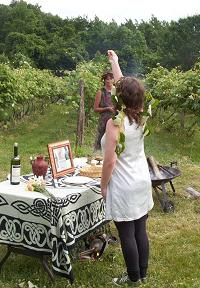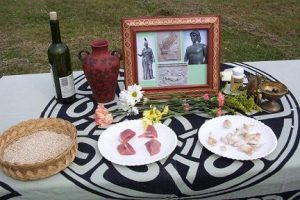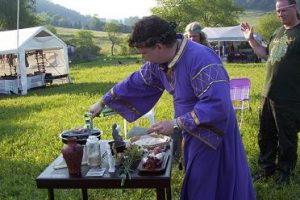by Melissa edited by Sean and other authors
(12 Skirophorion) Skiraphorion was the month of the final harvest of the grain and thus another major agricultural festival took place during this month, the three-day long Skira (Skiraphoria). Parke notes that “In the Skira the shaded procession to Skiron which originally concerned Athena and her rival deity on the Acropolis coincided with some mystic ritual of Demeter confined to female participants” (158). At Skiron, a precinct on the road to Eleusis near a sanctuary dedicated to Athena Skiras, Poseidon Pater, Demeter and Kore, the priests and priestesses did something pertaining to the fertility of the crops, since Plutarch mentions that one of the three “sacred plowings” of the Athenians took place at this time. Perhaps then, the “sacred plowing” in Skiraphorion entailed a blessing of the harvest or a thanksgiving for it or both. Coincidentally, the Bouphonia, another of the sacred plowings, occurred two days after this. This entailed a blessing for the oxen in honor of Zeus of the City, although its mythology is separate from the Hymn to Demeter.

The female responsibilities on one day of the festival involved what is probably one of the oddest proceedings in the Athenian year. Parke reasons, based on the note made by the scholar on Lucian’s description of holidays, that the decayed materials retrieved from chasms and placed on the altars during the Thesmophoria in the fall were probably cast into the chasms during Skiraphoria by female worshippers; had the materials been thrown into the chasms during the Thesmophoria, no decay would have yet occurred. The scholar’s note seems to suggest that, even as one agricultural cycle ended, the women were ensuring that the next cycle would begin properly.

The Skira was one of the few days when the women of ancient Athens would gather in public. The women withheld intercourse from the men on the day of the Skira, eating garlic to encourage them to stay away. The festival also involved a race to a shrine of Dionysos by young men carrying vine branches. According to Parke, the winner would receive a drink made of wine, honey, cheese, grain and olive oil–all the fruits which Athena Skiras was asked to bless (160).
Robertson states that the Skira are also “a professed ‘victory’ ritual” marking Athena’s victory over Poseidon for the city, a necessary observation before the Panathenaia a month later. However, since the priest of Helios goes in procession with the priestess of Athena and other women to the sacred site for the ritual of Skira, the festival has a likely connection to ensuring the best weather conditions for harvesting and threshing grain: lots of sun to dry it and no rain, hence the presence of the Sun priest. Wet weather comes from Poseidon, so the predominance of sun over rain is a success of Athena over Poseidon. Once the harvest is in and the threshing complete, the farmer is free to take part in the games.

Note: Helene P. Foley, in her background article on the Eleusinian Mysteries in her edition of The Homeric Hymn to Demeter, states that “all important rites of Demeter in Attica seem to have been linked (at least loosely) to stages of the agricultural year (71). Moreover, these festivals seem to have a connection with some part of the Homeric Hymn, especially since Eleusis, which was incorporated into Attica, was the site of much of the narrative of the Hymn. Thus Skira is part of the sacred festival cycle of grain in ancient Greece, along with the Proerosia (Oct), the Thesmophoria (also Oct), Haloa (Dec), the Lesser Mysteries (Feb), Thargelia (May) and the Eleusinian Mysteries (September).

Sources:
Foley, Helene P., ed., introduction, Homeric Hymn to Demeter, Princeton, 1994
Parke, H.W., Festivals of the Athenians, 1977
Robertson, Noel. “Athena’s Shrines and Festivals.” Worshipping Athena; Panathenaia & Parthenon, edited by Jennifer Neils, University of Wisconsin Press, 1996
